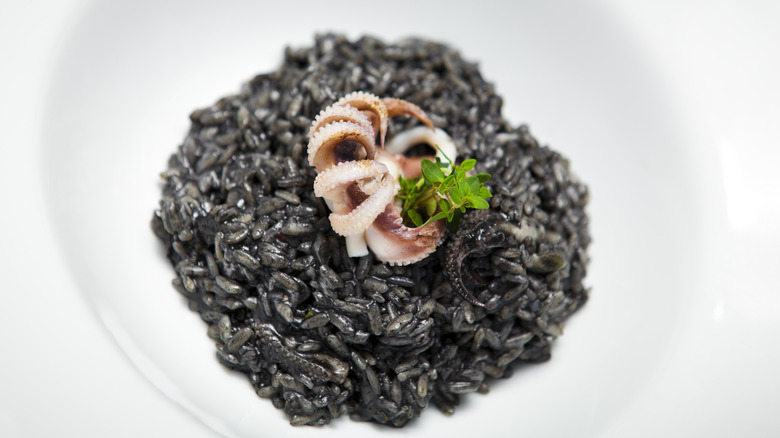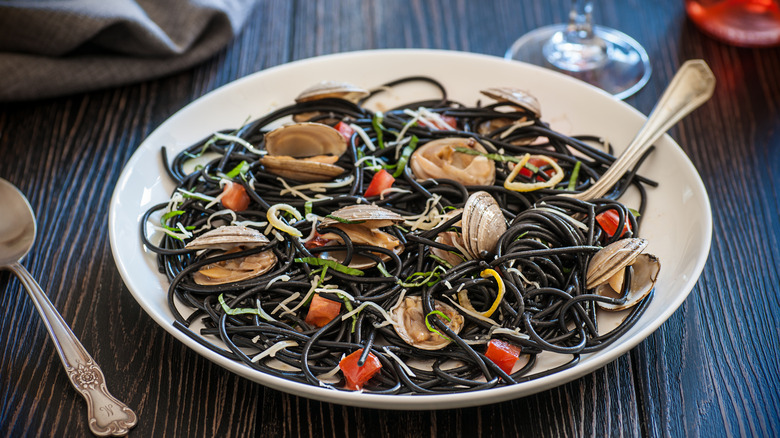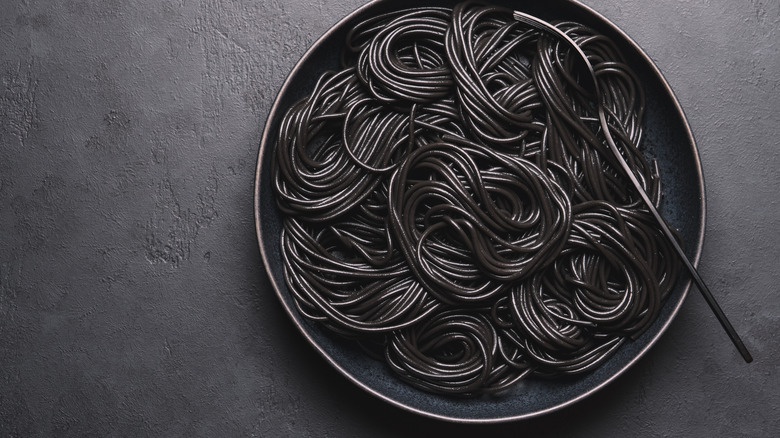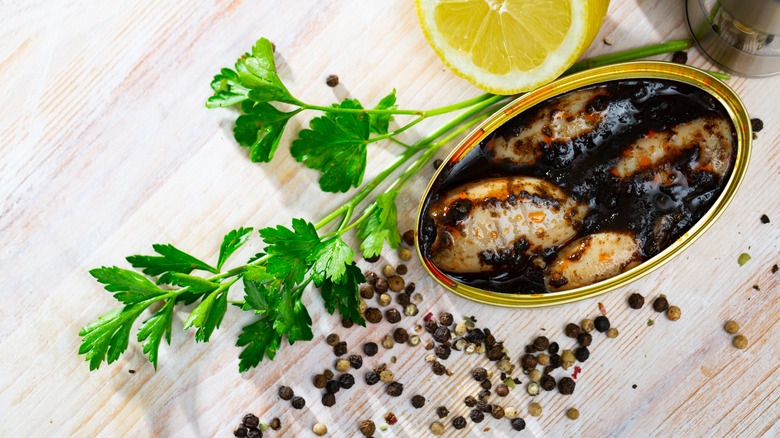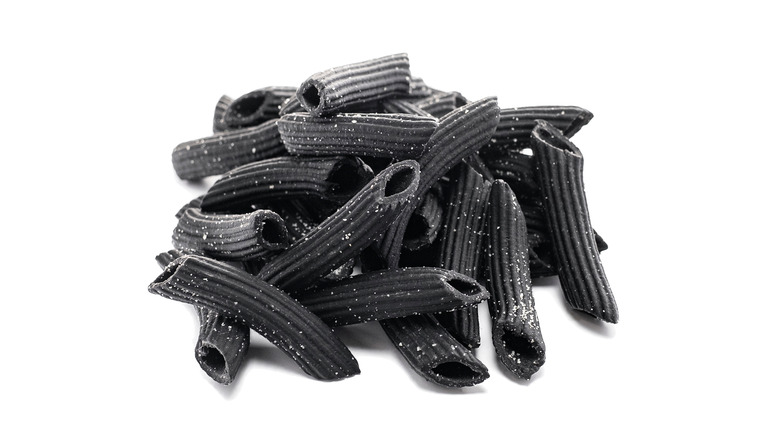What To Know About Squid Ink And The Bold Flavors It Brings To Your Dishes
Are you a fan of eating cephalopods? This group of sea creatures looks almost alien in appearance and includes squids, octopuses, and cuttlefish most prominently. Cephalopods capture the imagination and invoke fear in some with their undulating forms and slithering tentacles. To others, they are a treasured treat of the briny deep, delicious when grilled, seared, stewed, or fried. But, if you're only eating their bodies, then you aren't really getting the true culinary story of cephalopods.
Perhaps even more beloved than their sucker-covered tentacles is the ink they secrete as a defense mechanism. Used to bewilder and confuse predators, cephalopod ink has been consumed by humans for centuries, a testament to our willingness (and perhaps need) to not let anything of value go to waste.
Though commonly referred to as squid ink, the types of ink that humans use in cooking come from a variety of cephalopods. In fact, cuttlefish ink is more widely used than the ink from squids. All cephalopod inks share certain characteristics, including their distinct taste and deep, dark color, making them truly unique ingredients.
What is squid ink?
For clarity, we'll use "squid ink" as a catchall term for all cephalopod inks. Squid ink is collected from cephalopods that have been fished for sale as food. When butchering the animal, the silvery, dark ink sacs are carefully removed so as not to rupture them since the ink can stain almost anything that it touches. The ink is then expressed into containers to sell later. The amount of ink derived from each cephalopod varies and is generally dependent on the size of the animal. The ink is a powerful ingredient in terms of both flavor and color, and it can be diluted with water, vinegar, or both to greatly increase the usable amount harvested.
Most of the squid ink used in kitchens is actually the ink of cuttlefish, a close cousin to common squid. Though similar in many ways, there are some key differences that drive the use of cuttlefish ink over genuine squid ink. Cuttlefish ink is milder and less harsh in flavor, making it more approachable to unaccustomed palates. Cuttlefish ink is also closer to a shade of brown, while squid ink is blue-black. The color variance doesn't necessarily make one more preferable than the other, but for those looking to harness cephalopod ink primarily for its powerful color, the difference is worth noting.
What does squid ink taste like?
So, why is squid ink used in cooking? The answer is manifold and hinges on the flavor and the color of the substance. From an aesthetic standpoint, the rich, almost-black color that a few teaspoons of squid ink can give to a dish is almost otherworldly. We don't often encounter foods so dark and, when we do, it captivates us and draws our attention. This has led to its novelty application in a variety of dishes where the flavor is beside the point. Case in point, the "Squid Ink Burger" offered by McDonald's Japan, which featured buns blackened with ink.
But, what really drives fans of squid ink to the substance is the flavor. Similar to seafood delicacies like oysters and sea urchins, the unique flavor of squid ink that captures the essence of the ocean is unbeatable. Squid ink is briny on the tongue and possesses a deep, umami-rich body that is hard to capture in words. As such, it is typically used in dishes that contain other elements of seafood, such as the meat of cephalopods or other fish.
How to cook with squid ink?
Just as cephalopods are found throughout the world's oceans, so too is squid ink used in cuisines globally. Squid, octopus, and cuttlefish were — and still sometimes are — picked up as bycatch in large fishing nets, meaning that they aren't always the intended quarry but get caught all the same. Enterprising fishermen realized that they could get some use from these sea creatures and began eating them along with their primary catch.
Spain, a nation surrounded on many sides by the sea, has long prized squid ink as a foodstuff. The most well-known of the Spanish dishes that make use of squid ink is the Catalan and Valencian arròs negre. Translating to "black rice," this dish is similar to risotto or paella and includes both squid meat and squid ink along with garlic, peppers, paprika, olive oil, and seafood broth. The result is a rich dish with an arresting black color. A similar Valencian dish, fideuà negra, replaces the rice with noodles and comes with a tangy green aioli that offsets the dish's savory qualities.
Speaking of noodles, squid ink is often used to both flavor and dye fresh pasta. In Italy, pasta al nero di seppia is a dish of black noodles that packs much more flavor than ordinary noodles do. Here, the briny flavor of the noodles is accented simply with white wine, garlic, red pepper flakes, parsley, and a bit of squid meat.
Health benefits and nutritional value of squid ink
Given that it's used as a defense mechanism, many might think that squid ink is somehow poisonous. Though it bewilders predators who would seek to gobble up cephalopods and their young, the ink is purely a means of deception and camouflage and poses no harm to humans. In fact, squid ink may even have some health benefits.
According to Healthline, studies have shown strong evidence that squid ink could possess antimicrobial, antioxidant, and cancer-fighting properties. Additionally, it may also help lower blood pressure, combat ulcers, and boost immunity. From a nutritional standpoint, squid ink is rich in iron, copper, and potassium as well as the essential amino acid glutamate. Even more surprising, squid ink is high in dopamine. The same neurotransmitter that controls the reward center of the human brain is found in significant quantities in squid ink and can boost your memory and concentration as well as help ease anxiety.
Where to buy squid ink
Though not common in most grocery stores, squid ink is also not that hard to come by. Thankfully, cephalopods are plentiful in the world's oceans, so sourcing the ink is relatively easy. For those who want to get their hands on some, it can be harvested directly from whole, fresh squid and cuttlefish. Or, if that seems a bit too advanced, squid ink is sold in jars in specialty food stores, gourmet markets, and via online retailers in the U.S. and overseas.
The thought of eating unadulterated squid ink may still be too much for some to handle, and that's perfectly fine. Cook to your comfort level. For the timid who are still curious about the ingredient, seek out foodstuffs that already have squid ink incorporated into them. There are many varieties of dried pasta for sale that have been colored and flavored with squid ink and are ready to use straight from the box.
